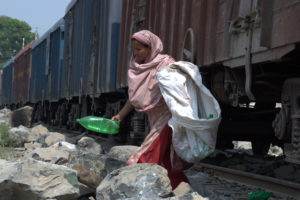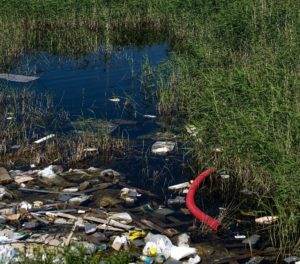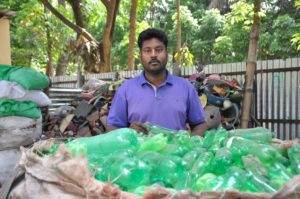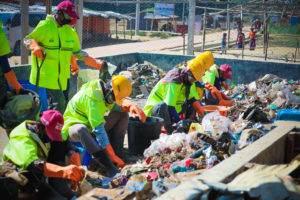The serious problem of plastic polluting our oceans has gained much public attention in recent years. Encouragingly, there have also been some very innovative solutions proposed to reduce the swathes of single-use detritus reaching the sea. Many have turned their attention to the key question, – ‘how does plastic get into the ocean?’.
While abandoned equipment from the fishing industry is one culprit, the obvious answer geographically-speaking is via our rivers. This article looks at the factors affecting the potential downstream drift of plastic waste, and which rivers are the biggest sources globally. We’ll also be introducing our own innovative solution to riverine pollution, currently being trialled in Bangladesh’s Padma River.
Ocean bound plastic
The world’s rivers carry vast amounts of plastic out to sea. The millions of tonnes washed downstream each year are estimated to equal the volume of 66,000 – 225,000 double-decker buses (that’s around 0.8m to 2.7m tonnes of plastic each year, according to the non-profit foundation, Ocean Clean-up). Moving further back up the waste chain, the reasons for discarded plastic finding its way into the waterways are varied, ranging from poor waste management and illegal dumping to microfibres escaping from our washing machine loads. Read more about how plastic gets into the ocean.
Once riverine plastic emissions reach the ocean, the effects are nearly impossible to reverse. Microplastics and larger plastic objects harm marine life and pose a threat to our health through the consumption of seafood.
Plastic in rivers
So, which of the world’s rivers are the biggest marine polluters when it comes to plastic?
Research has revealed that one thousand rivers are responsible for 80% of plastic in the ocean. The highest-ranking culprit is the Pasig River in the Philippines (which flows through the sprawling megalopolis of Manila). Since pollution is never present without people, it is inevitable that population density was proven to correlate to polluted catchments; 44 of the top 50 rivers on the list are in Asia.
Interestingly, shorter waterways were found to carry more waste than longer, meandering rivers, where the errant plastic tends to get buried in riverbeds, banks or beaches. This has put rivers that flow across small islands under the spotlight as priorities to be cleaned up (for example in the Philippines, Indonesia, and the Dominican Republic).
However, it would be far too simple to cast the blame upon these countries when our waste crisis is global in scale. Many wealthy countries export their plastic waste to developing countries’ shores, which significantly adds to the tidal flow of plastic pollution passing through estuaries. The UK has one of the worst track records in Europe, shipping out around 70% of its plastic refuse.
What is Practical Action doing?
It is clear that reducing the world’s consumption of single-use plastic products is paramount. But meanwhile, we also need to ensure that recyclable plastics reach recycling plants, and that such facilities are embedded into waste management systems wherever they are needed across the globe – there are many ways to fight plastic pollution.

At Practical Action, our team are trialling an innovative plastic recycling process in Faridpur, Bangladesh. Using a circular economy approach, we’re working with local waste workers’ cooperatives and entrepreneurs to transform previously unprofitable, low-grade plastic waste into a valuable commodity. With support from the Danish International Development Agency, Danida, we’ll team up with informal waste workers to collect plastic from the streets of Faridpur. The partnerships and links we are building between waste workers, private enterprises, communities and the local government will be key to establishing a reliable, functioning recycling system.
Much of the low-grade plastic targeted would otherwise end up polluting the Padma River, eventually making its way to the ocean. The refuse will be sorted so that mechanically recyclable plastic is first dealt with at an appropriate recycling plant. The remaining low-value plastic waste, usually dumped in landfill sites, can now be treated using next generation pyrolysis technology. By burning the plastic at very high temperatures in a vacuum, pyrolysis transforms it into clean high-grade oil, which can be used for transportation (in ships for example), and black carbon (used in print cartridges).
We have amassed significant experience in improving waste management systems across the globe, and we bring this insight to our new Bangladesh project. As well as reducing plastic pollution, the project will support informal waste workers to improve their incomes, working conditions, and the services they offer to local residents and businesses.
You can read more about the challenges facing waste workers in Faridpur, Bangladesh below, and learn what we’ve been doing to make their jobs more dignified and hygienic.
We are really excited about the potential of next-generation pyrolysis technology; we aim to build nine units at different locations along the river as the project develops. We can then review, refine and scale-up this solution in other cities around the world. The waste crisis is not simple, but our rivers deserve respect and care, not least because we rely on them. Follow us on social media to find out about more small solutions that catalyse big change.


